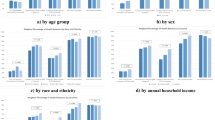Abstract
Introduction
Adoption of healthy lifestyles in cancer survivors has potential to reduce subsequent adverse health. We sought to determine the prevalence of tobacco use, alcohol use, and physical inactivity among cancer survivors overall and site-specific survivors.
Methods
We performed a cross-sectional analysis of the Massachusetts Behavioral Risk Factor Surveillance System, 2006–2008, and identified 1,670 survivors and 18,197 controls. Specific cancer sites included prostate, colorectal, female breast, and gynecologic (cervical, ovarian, uterine). Covariates included age, gender, race/ethnicity, education, income, marital status, health insurance, and physical and mental health. Gender stratified logistic regression models associated survivorship with each health behavior.
Results
4.9% of men and 7.7% of women reported a cancer history. In adjusted regression models, male survivors were similar to gender matched controls, while female survivors had comparable tobacco and alcohol use but had more physical inactivity than controls (OR 1.5; 95% CI, 1.2–1.8). By site, breast cancer survivors were more likely to be physically inactive (OR 1.5; 95% CI, 1.1–2.0) and gynecologic cancer survivors were more likely to report current tobacco use (OR 1.8; 95% CI, 1.2–2.8).
Conclusions and Implications for Cancer Survivors
Specific subgroups of cancer survivors are more likely to engage in unhealthy behaviors. Accurate assessment of who may derive the most benefit will aid public health programs to effectively target limited resources.
Similar content being viewed by others
References
SEER Cancer Statistics Review, 1975–2007. National Cancer Institute, 2010. Available at: http://seer.cancer.gov/csr/1975_2007/. Accessed July 9, 2010.
Gallicchio L, Kalesan B, Hoffman SC, Helzlsouer KJ. Non-cancer adverse health conditions and perceived health and function among cancer survivors participating in a community-based cohort study in Washington County, Maryland. J Cancer Surviv. 2008;2:12–9.
Demark-Wahnefried W, Pinto BM, Gritz ER. Promoting health and physical function among cancer survivors: potential for prevention and questions that remain. J Clin Oncol. 2006;24:5125–31.
American Cancer Society. Cancer Facts & Figures 2008. Atlanta: American Cancer Society; 2008.
Demark-Wahnefried W, Jones LW. Promoting a healthy lifestyle among cancer survivors. Hematol Oncol Clin North Am. 2008;22:319–42. viii.
Coups EJ, Ostroff JS. A population-based estimate of the prevalence of behavioral risk factors among adult cancer survivors and noncancer controls. Prev Med. 2005;40:702–11.
Eakin EG, Youlden DR, Baade PD, et al. Health behaviors of cancer survivors: data from an Australian population-based survey. Cancer Causes Control. 2007;18:881–94.
Bellizzi KM, Rowland JH, Jeffery DD, McNeel T. Health behaviors of cancer survivors: examining opportunities for cancer control intervention. J Clin Oncol. 2005;23:8884–93.
Behavioral Risk Factor Surveillance System: Frequently Asked Questions. Available at: http://www.cdc.gov/brfss/faqs.htm. Accessed July 6, 2010.
Brown DW, Balluz LS, Heath GW, et al. Associations between recommended levels of physical activity and health-related quality of life. Findings from the 2001 Behavioral Risk Factor Surveillance System (BRFSS) survey. Prev Med. 2003;37:520–8.
Centers for Disease Control and Prevention. Measuring Healthy Days: Population Assessment of Health-Related Quality of Life. Available at: http://www.cdc.gov/hrqol/pdfs/mhd.pdf. Accessed July 23, 2010.
Hennessy CH, Moriarty DG, Zack MM, Scherr PA, Brackbill R. Measuring health-related quality of life for public health surveillance. Public Health Rep. 1994;109:665–72.
Grimmett C, Wardle J, Steptoe A. Health behaviours in older cancer survivors in the English Longitudinal Study of Ageing. Eur J Cancer. 2009;45:2180–6.
McCorkle R, Tang ST, Greenwald H, Holcombe G, Lavery M. Factors related to depressive symptoms among long-term survivors of cervical cancer. Health Care Women Int. 2006;27:45–58.
Lasser K, Boyd JW, Woolhandler S, Himmelstein DU, McCormick D, Bor DH. Smoking and mental illness: a population-based prevalence study. JAMA. 2000;284:2606–10.
Schootman M, Deshpande AD, Pruitt SL, Aft R, Jeffe DB. National estimates of racial disparities in health status and behavioral risk factors among long-term cancer survivors and non-cancer controls. Cancer Causes Control. 2010;21(9):1387–95.
Hildesheim A, Herrero R, Castle PE, et al. HPV co-factors related to the development of cervical cancer: results from a population-based study in Costa Rica. Br J Cancer. 2001;84:1219–26.
Emery CF, Yang HC, Frierson GM, Peterson LJ, Suh S. Determinants of physical activity among women treated for breast cancer in a 5-year longitudinal follow-up investigation. Psychooncology. 2009;18:377–86.
Kapp JM, Jackson-Thompson J, Petroski GF, Schootman M. Reliability of health-related quality-of-life indicators in cancer survivors from a population-based sample, 2005, BRFSS. Public Health. 2009;123:321–5.
Centers for Disease Control and Prevention. National Center for Chronic Disease Prevention and Health Promotion Chronic Disease Indicators. Available at: http://apps.nccd.cdc.gov/cdi/Default.aspx. Accessed October 26, 2010.
Hamer M, Stamatakis E, Saxton JM. The impact of physical activity on all-cause mortality in men and women after a cancer diagnosis. Cancer Causes Control. 2009;20:225–31.
Holmes MD, Chen WY, Feskanich D, Kroenke CH, Colditz GA. Physical activity and survival after breast cancer diagnosis. JAMA. 2005;293:2479–86.
Alfano CM, Smith AW, Irwin ML, et al. Physical activity, long-term symptoms, and physical health-related quality of life among breast cancer survivors: a prospective analysis. J Cancer Surviv. 2007;1:116–28.
Acknowledgements
Thank you to Michael Winter, MPH for his statistical assistance.
Author information
Authors and Affiliations
Corresponding author
Rights and permissions
About this article
Cite this article
Linsky, A., Nyambose, J. & Battaglia, T.A. Lifestyle behaviors in Massachusetts adult cancer survivors. J Cancer Surviv 5, 27–34 (2011). https://doi.org/10.1007/s11764-010-0162-6
Received:
Accepted:
Published:
Issue Date:
DOI: https://doi.org/10.1007/s11764-010-0162-6




